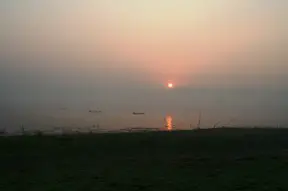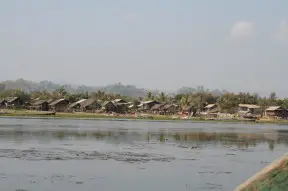Dario hysginon
Etymology
Dario: derived from the specific epithet of the type species, dario, which in turn is from its Bangla name, Darhi.
hysginon: from the Ancient Greek hysginon (ὕσγινον), meaning ‘a scarlet or crimson dye’, in reference to the conspicuous red colouration of males.
Classification
Order: Perciformes Family: Badidae
Distribution
Endemic to Myanmar where it has been recorded from small streams and tributaries close to the city of Myitkyina in Kachin State as well as in nearby Lake Indawgyi, the largest inland lake in Southeast Asia, with and all known habitats within the Irrawaddy/Ayeyarwady river system.
Other collections have occured further south near Mandalay city, Mandalay Division and these populations have been shown to vary slightly in meristics compared with those from the north of the country (Kullander and Britz, 2002).
Type locality is ‘Nan Kywe Chaung under bridge on road south to Mogaung, 25°20’20″N, 97°16’57″E, Irrawaddy River drainage, Myitkyina District, Kachin State, Myanmar’.
Lake Indawgyi and surrounding area were designated a protected zone by the Ministry of Ecotourism in 1999 and now form the Indawgyi Lake Wildlife Sanctuary.
Kachin State itself is one of the world’s great biodiversity hotspots and contains many endemic species although large portions of the area have already been decimated due to illegal logging.
Habitat
Displays a marked preference for small, often turbid pools with dense growths of aquatic plants or submerged grasses.
The type locality is a shallow (~ 1m depth during the dry season), clear water stream with a sand and pebble substrate which flows through both secondary forest and agricultural land.
The water is described as having a moderate current with grassy marginal vegetation and a Cryptocoryne sp. growing submerse.
D. hysginon occurs sympatrically with Badis corycaeus and B. kyar with the three occupying different ecological niches; B. corycaeus is found in running water towards the margins of the stream, B. kyar in the faster flow towards the centre and D. hysginon only in still pools around the shoreline.
A number of other fishes were found at this location from Acanthocobitis, Schistura, Danio and Puntius to Pillaia, Indostomus and Microphis species.
In Lake Indawgyi it occurs alongside B. corycaeus with both species collected from heavily-vegetated marginal zones.
The substrate of the lake is a soft, rich clay mixed with high levels of decomposing plant material, while aquatic vegetation and various kinds of algae proliferate including Vallisneria, Elodea and Spirogyra species.
According to Kullander and Britz (2002) D. hysginon is most abundant in marginal, marshy zones containing stagnant water with sympatric fishes including Parasphaerichthys ocellatus, Heteropneustes fossilis, Oryzias, Esomus, Channa and Anabas species; all typical inhabitants of oxygen-deprived environments.
Maximum Standard Length
One of the smallest percoid fishes known. Males grow to around 20 mm and females 15 mm.
Aquarium SizeTop ↑
A pair or single male with multiple females can be housed in an aquarium with base dimensions of 45 ∗ 30 cm or more.
Maintenance
Best-maintained in a well-structured arrangement with plenty of cover.
A soft substrate is preferable although fine-grade gravel is acceptable, while ideal plants include Cryptocoryne spp. or those that can be grown attached to the décor such as Microsorum, Anubias, or Taxiphyllum species.
The latter is particularly useful as it’s also an ideal spawning substrate, and driftwood branches, floating plants and leaf litter can all be used as well.
Water Conditions
Temperature: It is subject to seasonal temperature fluctuations in nature and is comfortable within the range 59 – 77°F/15 – 25°C with even greater extremes being tolerated for short periods. In many countries/well-insulated homes it can be therefore maintained without artificial heating year-round.
Higher temperatures are known to stimulate spawning activity meaning a heater will be required if you want to breed the fish outside of spring and summer months though. Set it to around 20 – 24 °C for long-term care and breeding.
pH: Prefers neutral to alkaline water with a value between 6.5 – 7.5.
Hardness: The water in northern Myanmar is typically soft despite the relatively high pH so aim for somewhere within the range 18 – 90 ppm.
Diet
Dario species are micropredators feeding on small aquatic crustaceans, worms, insect larvae and other zooplankton.
In captivity they should be offered small live or frozen fare such as Artemia nauplii, Daphnia, grindal, micro-, and banana worm.
They’re noted as somewhat shy, deliberate feeders (see ‘Behaviour and Compatibility’) and it’s also important to note that all badids develop issues with obesity and become more susceptible to disease when fed chironomid larvae (bloodworm) and/or Tubifex so these should be omitted from the diet.
Behaviour and CompatibilityTop ↑
Given its rarity the emphasis should be on captive reproduction and we strongly recommend maintaining it alone.
It’s not a gregarious fish as such and rival males can be very aggressive towards one another, especially in smaller tanks.
In these cases only a single pair or one male and several females should be purchased but in roomier surroundings a group can coexist provided there is space for each male to establish a territory and plenty of broken lines of sight.
Thoughtful placement of caves and boundaries can help tremendously in this respect so don’t be tempted to cluster all available spawning sites in one area of the tank, for example.
If you do intend to house it in a community tankmates must be chosen with care.
It’s slow-moving with a retiring nature and will easily be intimidated or outcompeted for food by larger or more boisterous tankmates.
Peaceful, pelagic cyprinids such as Microdevario, Boraras, Trigonostigma or smaller Rasbora species make good choices as do diminutive loaches such as some members of the genus Petruichthys.
Sexual Dimorphism
This species is very easy to sex but often only males are traded.
Males are far more colourful and develop extended pelvic, dorsal and anal fins than females as they mature.
In addition females are smaller and possess a noticeably shorter, stumpier-looking body profile then males.
Reproduction
Substrate-spawner forming temporary pair bonds.
Other fishes are best omitted if you want to raise good numbers of fry, although in a mature, well-furnished community a few may survive to adulthood.
Either a single pair or a group of adults can be used but if using multiple males be sure to provide each with space to form a territory with around 30 cm² per individual adequate.
One male will usually become dominant meaning the others will not be involved in breeding.
Water parameters should be within the values suggested above and the fish conditioned with plenty of live and frozen foods.
As they come into breeding condition males will begin to form territories and display courtship behaviour alongside an intensified colour pattern.
This can be prolonged for several days with the female often being chased away then courted again minutes later.
The male will make a non-aggressive approach towards the female and appear to ‘invite’ her into the centre of his territory, and if ready to spawn she will follow.
The act itself is over in just a few seconds with eggs being scattered in a random fashion on the underside of a solid surface such as a plant leaf.
Post-spawning the female is ejected and the male takes sole responsibility for the territory.
If you want to maximise the numbers of fry raised now is the time to either remove the medium to a container containing water from the spawning tank or the adults as the fry will be preyed upon once hatched.
The incubation period should be 2-3 days after which the fry may need up to a week to fully absorb the yolk sac.
They are very small indeed and will require an infusoria-type diet until large enough to accept microworm, Artemia nauplii, and suchlike.
NotesTop ↑
This species is traded under various names such as ‘red melon Dario‘ or ‘flame red Dario‘.
Among congeners D. dayingensis is most similar since it differs only in a few meristic counts and by its slightly larger adult size.
D. hysginon can be told apart by possession of 22-24, usually 23, lateral scales (vs. 24-25 in D. dayingensis), 8½ (vs. 9½) scales in the transverse scale row, and absence (vs. presence) of palatine teeth in the upper jaw.
A beautiful, striped colour form which aquarists have referred to as Dario sp. ‘Myanmar’, D. sp. ‘pyjamas’ , D. sp. ‘black tiger’ and ‘fire red tiger badis’ among other names is also available sporadically.
Little is known about this fish except that two male specimens were included in the type series of D. hysginon and collected to the north of Myitkyina in Kachin State.
Despite the striking differences in colour pattern it’s officially recognised as a colour form of D. hysginon as per Kullander and Britz (2002) although D. sp. ‘Myanmar’ is now known to have an appreciably larger adult size (S. van der Voort, pers. comm.).
Females are also distinguishable from those of D. hysginon, plus the two will not hybridise with each other in aquaria, so we’ve included them separately for the time being.
Dario currently contains five species, of which four are considered miniature species since they do not exceed 26 mm in standard length (SL).
The fifth, D. urops, not only grows larger, to at least 28.0 mm SL, but occurs in southwestern India whereas the others are native to the Brahmaputra, Meghna, and Ayeyarwaddy river systems in northern India, Myanmar, and southwestern China, and this raises interesting questions regarding their biogeography.
In addition, D. urops lacks some diagnostic characters of Dario and thus may represent the sister group to other members of the genus, though this hypothesis remains to be tested.
Prior to 2002 the family Badidae included just five species but an extensive revision paper published that year contained descriptions of ten new species along with the genus Dario of which the former Badis dario was designated type species.
Dario is most easily distinguished from Badis by the small adult size of member species, predominantly red colouration, more extended first few dorsal rays and pectoral fins in males, straight-edged (vs. rounded) caudal-fin, lack of visible lateral line and less-involved parental behaviour.
Badids have historically been considered members of the families Nandidae or Pristolepididae and it was not until 1968 that Barlow proposed a separate grouping for them.
They share some characteristics with anabantoids, nandids and channids, perhaps most notably the typical spawning embrace in which the male wraps his body around that of the female.
More recent studies have concluded that this procedure is an ancient trait inherited from a common ancestor to all these families.
All Badis, Dario and Nandus species were found to share a uniquely bifurcated (split) hemal spine on the penultimate vertebra and this may provide evidence that the group is monophyletic (Kullander and Britz, 2002).
The family Nandidae is currently restricted to include only Nandus species and it’s separated from Badidae by differences in morphology and egg structure with their phylogenetic relationships yet to be studied in detail.
References
- Kullander, S. O. and R. Britz, 2002 - Ichthyological Exploration of Freshwaters 13(4): 295-372
Revision of the family Badidae (Teleostei: Perciformes), with description of a new genus and ten new species. - Britz, R. and S. O. Kullander, 2013 - Zootaxa 3731(3): 331-337
Dario kajal, a new species of badid fish from Meghalaya, India (Teleostei: Badidae). - Britz, R., A. Ali and S. Philip, 2012 - Zootaxa 3348: 63-68
Dario urops, a new species of badid fish from the Western Ghats, southern India (Teleostei: Percomorpha: Badidae). - Rüber, L., R. Britz, S. O. Kullander and R. Zardoya, 2004 - Molecular Phylogenetics and Evolution 32(3): 1010-1022
Evolutionary and biogeographic patterns of the Badidae (Teleostei: Perciformes) inferred from mitochondrial and nuclear DNA sequence data.








August 25th, 2012 at 5:11 pm
I find this Dario species to be much easier to feed, readily accepting pellets and fine flake foods as well as gel diets. They are also considerably easier to sex, and breed readily when provided with some leaf litter.
January 4th, 2014 at 7:27 pm
[…] […]